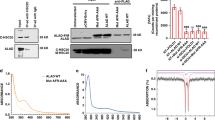Abstract
Heme is a necessary component in a variety of oxygen-binding proteins and electron-transfer proteins, and as such it occupies a central role in cellular and organismal metabolism. With only rare exceptions, organisms that utilize heme possess the entire biosynthetic pathway to produce this tetrapyrrole compound. The enzymes involved catalyze a variety of interesting reactions and utilize both common and unique cofactors and metals. Aminolevulinate dehydratase from all organisms and ferrochelatase from higher animals are both metalloenzymes, while 5-aminolevulinate synthase contains pyridoxal phosphate, and porphobilinogen deaminase possesses a unique dipyrrole cofactor. Two pathway enzymes catalyze multiple decarboxylations and yet have no cofactors, and one enzyme catalyzes a six-electron oxidation with a single FAD. To add additional scientific interest there exist biochemically and clinically distinct human genetic diseases for every step in this pathway.
Similar content being viewed by others
Author information
Authors and Affiliations
Additional information
Received: 12 March 1997 / Accepted: 8 May 1997
Rights and permissions
About this article
Cite this article
Dailey, H. Enzymes of heme biosynthesis. JBIC 2, 411–417 (1997). https://doi.org/10.1007/s007750050151
Issue Date:
DOI: https://doi.org/10.1007/s007750050151




